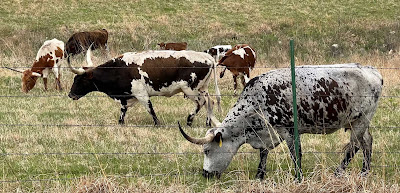.jpg) |
| 'Hope for Humanity' |
In the back of my mind, ProfessorRoush has a little nagging voice that keeps saying "you should post, it has been awhile," but I would not have thought that I wouldn't post during the entire month of August. My, how it flew by!
I blame the unusual weather, more rain than usual, and temperatures that kept weeds growing and me mowing weekend after weekend. I blame my unfortunate needs for cash, which keep me working long hours during the week, ticking down the clock of my life, time I can't replace no matter how valuable I think it is in the moment. And I blame me, for not making the blog a bigger priority over eating, sleeping, target-shooting, reading, watching TV, or the hundreds of other distractions that occupy my time.
.jpg) |
| Liatris spicata |
But then a fall morning comes, like this morning, and it's cool (53ºF) and sunny, and I'm walking with Bella down the road at 7:10 a.m., and I remember that a beautiful world awaits, every single morning, if I only take time to look.
Time to look and stop to take a quick photo of 'Hope for Humanity', pictured at the top. There has to indeed be some hope for a species that breeds and distributes a rose this beautiful.
Time to pause on the walk and relish the beauty of this clump of
Liatris spicata, returning year after year to the roadside northeast of the house. A "blazing star" of the highest magnitude (see what I did there?).
Time to appreciate that the Kansas state flower is the native Sunflower, thriving where the ground is disturbed by hoof or man, a roadside beacon to reflect the morning sunshine.
.jpg) |
| 'Morden Sunrise' |
Time to fawn over the delicately hued petals of this 'Morden Sunrise', a Parkland Canadian rose bred by Lynn Collicutt and Campbell Davidson in 1991. I have one in front, 3 feet tall and now overshadowed by a "dwarf" lilac, and this second two-year-old in back.
.jpg) |
| 'Comte de Chambord' |
Time to stop and "smell the roses", in this case the Portland rose 'Comte de Chambord', a reliable bloomer and cane hardy to the toughest Kansas winters. She looks fragile and virginal and perfect, but she's touch as nails.
And time to appreciate all the beautiful and more mobile creatures who share the morning walks with Bella and I. For the city folk reading this blog, the behavior of the left hand male bovine at the rear of the longhorn cow may look strange, but to an old farm-boy and veterinarian, it's anything but. That cow had just hunched up and passed urine and he's checking to see (the "Flehmen response") if this particular cow is available for some morning "go-time". Truly, there's nothing more natural on the prairie than a little lovin' at the first rays of the sun.
I think we'll just leave this blog entry right here, in a light and educational moment, and not veer off into the weeds of biology trying to extend it.
.jpg) Thankfully, on a brighter note, even a two mower-wide swath didn't reach these fledgling Liatris further down the road. I can only hope to see these mature and spread across the untouched prairie of our neighborhood.
Thankfully, on a brighter note, even a two mower-wide swath didn't reach these fledgling Liatris further down the road. I can only hope to see these mature and spread across the untouched prairie of our neighborhood..jpg)
.jpg)
.jpg)
.jpg)
.jpg)
.jpg)
.jpg)
.jpg)
.jpg)
.jpg)
.jpg)
.jpg)
.jpg)


.jpg)
.jpg)

.jpg)
.jpg)

%201.jpg)

.jpg)
.jpg)
.jpg)
.jpg)

.jpg)
.jpg)
.jpg)


.jpg)
.jpg)
.jpg)
.jpg)
.jpg)
.jpg)
.jpg)
.jpg)
.jpg)
.jpg)
.jpg)
.jpg)

.jpg)
.jpg)


.jpg)
.jpg)
.jpg)
.jpg)